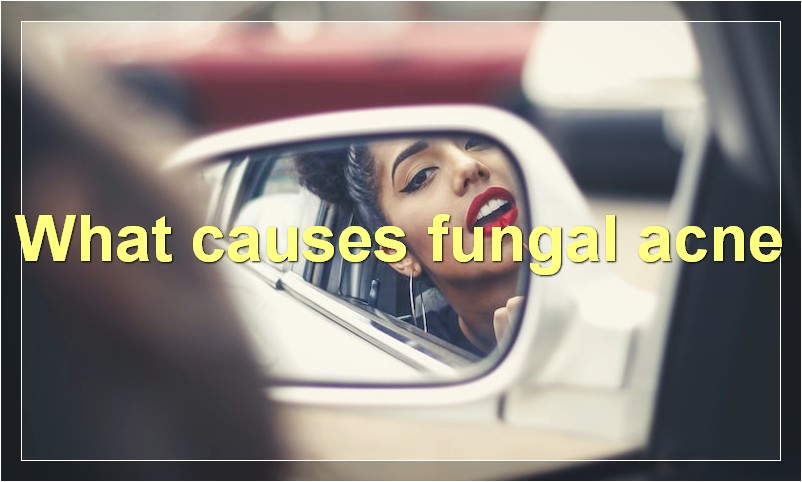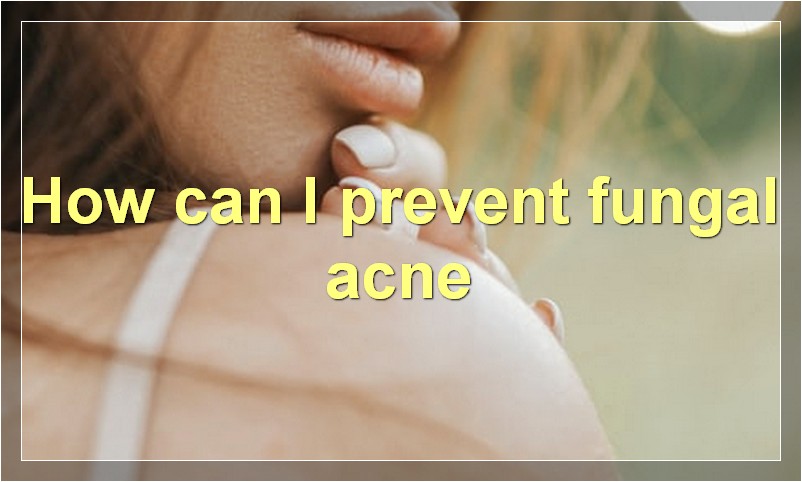Fungal acne is a skin condition that can be caused by a number of things, including certain medications, cosmetics, and even tight-fitting clothing. While it may look similar to traditional acne, there are some key differences that can help you identify it. Fungal acne is often characterized by red, scaly patches on the skin that may be itchy or sore. If you think you might have fungal acne, there are a few things you can do to treat it.
What are the symptoms of fungal acne
Fungal acne is a skin condition caused by an overgrowth of yeast on the skin. The most common symptoms of fungal acne are small, red bumps on the skin that are often itchy or painful. Other symptoms include flaking, scaling, or crusting of the skin. Fungal acne is often mistaken for other skin conditions such as acne, eczema, or psoriasis.
Fungal acne is most commonly found on the face, neck, chest, and back. The condition can also affect the scalp, causing dandruff-like flakes. Fungal acne is not contagious and cannot be passed from person to person.
There are several things that can trigger an overgrowth of yeast on the skin, including humid weather, sweating, tight clothing, and certain medications. Treatment for fungal acne typically includes antifungal creams or lotions. In severe cases, oral antifungal medication may be necessary.
What causes fungal acne

Fungal acne is a type of skin condition that is caused by an overgrowth of yeast on the skin. Yeast is a type of fungus that is naturally present on the skin, but when it grows too much, it can cause problems. Fungal acne can cause red, scaly, and itchy skin. It is most commonly found on the face, chest, back, and shoulders. Fungal acne is not caused by dirt or oil, so washing more often will not help. The best way to treat fungal acne is with antifungal creams or lotions.
How is fungal acne treated
Fungal acne is a skin condition that is caused by an overgrowth of yeast on the skin. The symptoms of fungal acne include whiteheads, blackheads, and pimples. Fungal acne is treated with antifungal medications. These medications can be taken orally or applied to the skin.
What is the prognosis for fungal acne
Fungal acne is a type of skin infection that is caused by a fungus. The most common type of fungal acne is tinea versicolor, which is a superficial fungal infection of the skin. The symptoms of fungal acne include redness, itching, and scaling of the skin. Treatment of fungal acne typically involves the use of antifungal medications.
Are there any home remedies for fungal acne
If you’re struggling with fungal acne, you’re not alone. This pesky skin condition can be difficult to treat, but there are a few things you can do at home to help clear it up.
Fungal acne is caused by an overgrowth of yeast on the skin. When this happens, the yeast produces enzymes that break down the sebum in your pores, leading to inflammation and pimples.
There are a few things you can do at home to help treat fungal acne:
1. Keep your skin clean. Wash your face twice a day with a gentle cleanser. Be sure to remove all makeup before you go to bed.
2. Exfoliate regularly. Use a gentle exfoliating scrub or brush to remove dead skin cells and help keep your pores clear.
3. Apply a topical antifungal cream or lotion. These products can help kill the yeast that’s causing your fungal acne.
4. Try tea tree oil. This natural oil has antifungal properties that may help clear up your fungal acne.
5. Avoid triggers. Things like sweating, tight clothing, and hot, humid weather can make fungal acne worse. If you can, avoid these triggers or take steps to manage them (like showering right after working out).
If you’re struggling with fungal acne, don’t despair. There are a few things you can do at home to help clear it up. With some patience and effort, you can get your skin back to looking and feeling its best.
How can I prevent fungal acne

Acne is a common skin condition that affects people of all ages. While there are many different types of acne, fungal acne is a specific type that is caused by a yeast infection. Fungal acne can appear on the face, back, chest, and even in the hair. It is often characterized by red, itchy bumps that may be filled with pus.
There are many different ways to prevent and treat fungal acne. The first step is to identify the cause of the infection. Once the cause is identified, you can take steps to prevent the infection from happening again. If you have a yeast infection, you may need to take antifungal medication. You can also use topical treatments to kill the yeast on your skin.
In addition to taking medication, there are several things you can do at home to prevent fungal acne from happening. First, make sure you keep your skin clean. Wash your face twice a day with a mild cleanser. Avoid scrubbing your skin too hard, as this can irritate the skin and make the acne worse. Secondly, avoid using oily or greasy cosmetics and skincare products. These can block pores and lead to breakouts. Finally, avoid touching your face too much. Touching your face can transfer bacteria and oils from your hands to your face, which can clog pores and cause acne.
If you do develop fungal acne, there are several things you can do to treat it. Over-the-counter antifungal creams and lotions can help kill the yeast on your skin. You may also need to take oral antifungal medication if the acne is severe. In some cases, isotretinoin (Accutane) may be prescribed by a dermatologist. This medication can help to clear up even the most severe cases of fungal acne.
What are some common triggers for fungal acne
Fungal acne is a skin condition caused by an overgrowth of yeast on the skin. The most common triggers for fungal acne are sweaty or humid conditions, using oily cosmetics, and taking certain medications. Fungal acne often looks like traditional acne, with small bumps or pimples on the skin. However, it is important to see a dermatologist to confirm the diagnosis, as some other skin conditions can look similar. Treatment for fungal acne typically involves antifungal medications, both topical and oral.
Is fungal acne contagious
Fungal acne is not contagious. However, the fungus that causes it, pityrosporum ovale, is present on the skin of many people. When this fungus grows out of control, it can cause the pimple-like bumps known as fungal acne.
Fungal acne is most often seen on the face, chest, and back. It can also occur on the buttocks and thighs. The bumps are usually small, red, and scaly. They may be itchy or painful. In some cases, they can even lead to hair loss.
While fungal acne is not contagious, it can be difficult to get rid of. The best way to treat it is with an antifungal cream or lotion. These products are available without a prescription. Your doctor may also prescribe an oral antifungal medication if your case is severe.
If you have fungal acne, be sure to wash your face twice a day with a mild cleanser. Avoid scrubbing or picking at the bumps. Doing so can lead to infection and scarring.
What should I do if I think I have fungal acne
If you think you might have fungal acne, there are a few things you can do to confirm your suspicions and get rid of the problem for good.
First, take a close look at your skin. Fungal acne appears as small, red bumps that are often clustered together. They may be accompanied by itchiness, dryness, and flakiness. If you see any of these signs, it’s time to take action.
Next, try using an over-the-counter antifungal cream or lotion. These products are designed to kill the fungus that causes fungal acne. Apply the cream or lotion to the affected area and let it sit for a few minutes before rinsing it off.
If the over-the-counter treatments don’t work, or if your fungal acne is severe, you may need to see a dermatologist for prescription-strength medication. Either way, with treatment, you should start seeing improvement within a few weeks.
In the meantime, there are a few things you can do to soothe your skin and prevent the fungus from spreading. Avoid picking at your skin, which can cause the fungus to spread. And, use a gentle cleanser and moisturizer to keep your skin hydrated and free from irritants.
With a little care and treatment, you can get rid of fungal acne for good.
Can men get fungal acne
Fungal acne is a type of skin condition that is often mistaken for regular acne. It is caused by an overgrowth of yeast on the skin, which can clog pores and lead to breakouts. While it is more common in women, it can affect men as well. Fungal acne often looks like small, red bumps on the skin that may be itchy or sore. It can also cause whiteheads, blackheads, and pimples. While it is not dangerous, it can be uncomfortable and frustrating. There are several ways to treat fungal acne, including over-the-counter antifungal creams and oral medications.





